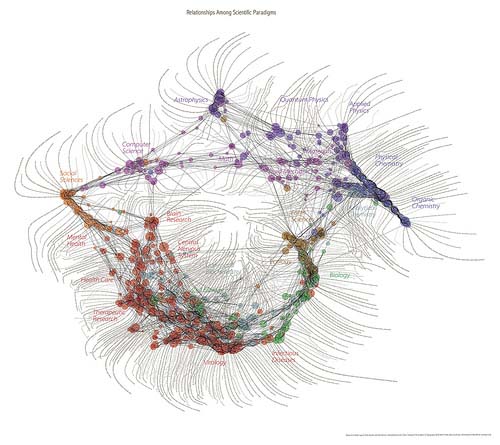|
Paradigms
|
|
|
Relations between scientific paradigms -
This map was constructed by sorting roughly 800,000 published papers into 776 different scientific paradigms (shown as pale circular nodes) based on how often the papers were cited together by authors of other papers.
|
Paradigms
Paradigms are ways of thinking. The term 'paradigm' is usually credited to Thomas Kuhn. He built on the concept of a process of making ideas, spelled out by Ludwig Wittgenstein, and applied it to science. He said it was as a set of 'universally recognised scientific achievements that for a time provide model problems and solutions to a community of practitioners'. A classic example is how Newtonian physics was the dominant paradigm for centuries until various inconsistencies were answered better by Einstein's theories of relativity. Paradigms are like the scaffold/structure, within which the exepriments and eventual building takes place. Different structures ask different questions, and so come to very different answers. "Productionist" Paradigm Food Production for the past 50 years has taken place within an existing paradigm - the paradigm to produce more. Sounds sensible enough - it is such a powerful paradigm that few would say there is anything wrong with that aim. The classic and longest running ecological experiment in the world is at Rothamsted Research Station started over 150 years ago. These plots was designed to find out whether continued use of fertilisers reduced the potential of that soil to maintain high yields over time. After 150 years the yields are maintained. This way of thinking is called the "Productionist Paradigm". The essential of this is that it focuses completely on yield considerations. This in turn is usually based on increasing 'productivity' as the driving force of this paradigm. There are various measures of yield, not just absolute outputs. It may be total yield, it may be yield/area, yield / fertilser input, yield/labour input, yield/cost input (there comes a point where the input costs outweigh the increased output). And it is completely sensible to concentrate on yields - to get the best returns for what you put in. Many Nobel prizes have been awarded to those who have helped increase yields of food crops, from Haber (below) to Borluag, father of the Green Revolution. But... This doesn't ask other questions like: 1) How much do N fertilisers contribute to Global Warming? Nitrogen fertilisers now account for 38% of agricultural GHG emissions (1/5th of) worldwide emissions (Stern Review). In UK Nitrous oxides (from fertilsers) account 6-7% of all UK GHG emissions - 3X more than all internal & external UK aviation. You can read about average yields of 7.74t/ha of wheat since 2000. But this seeming accuracy hides the phenomenal variety that is agriculture. And to measure this variability Ron Fisher @ Rothamsted developed statistics. Statistics sets out to measure the variability, in terms of size and diversity, in order to determine whether a variation is a 'significant' deviation from the norm in that population - or just part of the inherent variability. We tend to only talk about the best lands - to produce best yields. There is less attention to those areas where you cannot get highest yields (ie return per input - whether land, labour or chemical). And.... The scientists (like me) live in one world, while the food crops end up in another. The farmers and the scientists want to increase yields. Obvious. How could it be otherwise. But...when those crops hit the markets...what happens? The price goes down. It is the iron law of the markets that if output goes up - then prices go down. When crops are scarce, prices go up. Read it everyday in the financial newspapers. So it is even more important that other costs are cut - particularly those to health and the environment. Costs to the environment & health are ignored and not taken into consideration. It is only recently that we are realising that the natural environment provides a wide variety of services (eg cleaning up the rivers/atmosphere) that are never included in the calculations. That is why we are coming to a food crunch now. Two further paradigms are battling to take over the existing one. " Both are grounded in the science of biology, but each interprets biological and societal systems in ways that offer differing choices for our future: how food is produced, who produces it and how it is sold.; questions of social justice, where the food is produced (global versus local sourcing) and the place of food in human health". Food Wars. The concentration on biology of the two emerging paradigms, with Bio being put in front of many words, reflects the change from a chemically driven (fertiliser/pesticides) form of production to a more biological one - witness GM. Life Science Paradigm BASF/Monsanto want more biotechnology - cleverly engineered plants that deal with water stress, and other environmental constraints while also providing better nutrition. This reflects a paradigm of thinking that integrates the 'life sciences'. CEO of Monsanto said in 1998 (in Food Wars): The previously separate domains of agriculture, nutrition and health should now be managed as an interconnected system. We use "Life Sciences" to describe that system", Some say this is nothing more than the old paradigm with similar strengths and weaknesses. Ecological & Public Health Paradigm While also grounded in the science of biology, this takes a more inegrative and less engineering approach to nature. Its core assumption recognises mutual dependencies, symbiotic relationships and more subtle forms of manipulation and its aim is to preserve ecological diversity. It takes a more holistic view that the "medicalised" ne in Life Sciences.. This paradigm is based on Environment and Public health - rather individual illhealth, solutions. It aims to prevent symptoms of ill health appearing and of reducing pollutants to air at source - rather than making money by trying to cure the ills afterward. Global food policies would work with nature rather than against it. |

